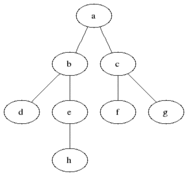Breadth-first search facts for kids
Imagine you have a big maze or a network of friends. How would you find your way or connect with everyone? In computer science, there's a clever method called breadth-first search (BFS). It's a way to explore connections in a structured way.
BFS starts at one specific point, like your starting position in a game. Then, it checks all the places directly connected to it, like your immediate neighbors. After that, it moves to the next "layer" of connections. It explores all items at the current depth before moving to items at the next depth. Think of it like ripples spreading out in a pond! If you use BFS on a tree (data structure), it's called a level-order traversal.
Contents
How BFS Works
BFS explores a network step by step, layer by layer. It makes sure to visit all the closest spots first. This is different from other methods that might go deep down one path before checking others.
Starting the Search
First, you pick a starting point. This is where your search begins. Imagine you are at the center of a spiderweb.
Exploring Neighbors
Next, BFS looks at all the places directly connected to your starting point. These are your immediate neighbors. It adds them to a list of places to visit.
Moving to the Next Layer
Once all immediate neighbors are checked, BFS moves on. It then looks at the neighbors of those neighbors. It continues this process, always checking all connections at the current "distance" before going further out.
Finding the Goal
BFS keeps going layer by layer until it finds what it's looking for. Or, it might explore every possible connection if it needs to. This method is great for finding the shortest path between two points.
Where BFS is Used
BFS is a very useful tool in many areas of computer science and beyond.
Finding Shortest Paths
One of the main uses of BFS is to find the shortest path. For example, it can find the fewest number of steps to get from one place to another. This is helpful in navigation apps like GPS.
Social Networks
On social media, BFS can help find connections. It can show you all your friends, then your friends' friends, and so on. This helps map out how people are connected.
Web Crawlers
Search engines use BFS-like methods to explore the internet. They start from a webpage and then visit all the links on that page. Then they visit links on those pages, and so on. This helps them find and index new websites.
Solving Puzzles
BFS can also solve puzzles like mazes or Rubik's Cubes. It explores all possible moves layer by layer. This helps find the quickest solution.
Related Searches
Images for kids
See also
 In Spanish: Búsqueda en anchura para niños
In Spanish: Búsqueda en anchura para niños



